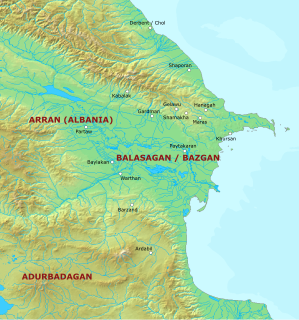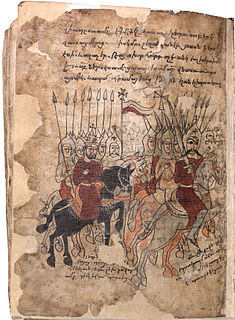
Peroz I was the Sasanian King of Kings of Iran from 459 to 484. A son of Yazdegerd II, he disputed the rule of his elder brother and incumbent king Hormizd III, eventually seizing the throne after a two-year struggle. His reign was marked by war and famine. Early in his reign, he successfully quelled a rebellion in Caucasian Albania in the west, and put an end to the Kidarites in the east, briefly expanding Sasanian rule into Tokharistan, where he issued gold coins with his likeness at Balkh. Simultaneously, Iran was suffering from a seven-year famine. He soon clashed with the former subjects of the Kidarites, the Hephthalites, who possibly had previously helped him to gain his throne. He was defeated and captured twice by the Hephthalites and lost his recently acquired possessions.

Shapur III, was the Sasanian King of Kings of Iran from 383 to 388. He was the son of Shapur II and succeeded his uncle Ardashir II.

Ardashir II, was the Sasanian King of Kings of Iran from 379 to 383. He was the brother of his predecessor, Shapur II, under whom he had served as vassal king of Adiabene, where he fought alongside his brother against the Romans. Ardashir II was appointed as his brother's successor to rule interimly till the latter's son Shapur III reached adulthood. Ardashir II's short reign was largely uneventful, with the Sasanians unsuccessfully trying to maintain rule over Armenia.

Mamikonian or Mamikonean was an aristocratic dynasty which dominated Armenian politics between the 4th and 8th century. They were the most notable noble house in Early Christian Armenia after the ruling Arsacid dynasty and held the hereditary positions of sparapet and dayeak, allowing them to play the role of kingmaker for the later Armenian kings. They ruled over extensive territories, including the Armenian regions of Tayk, Taron, Sasun, and Bagrevand, among others. The Mamikonians had a reputation as supporters of the Roman Empire in Armenia against Sasanian Iran, although they also served as viceroys under Persian rule. Their influence over Armenian affairs began to decline at the end of the 6th century and suffered a final, decisive blow after a failed rebellion against Arab rule over Armenia in 774/75.
Pahlavuni was an Armenian noble family, a branch of the Kamsarakan, that rose to prominence in the late 10th century during the last years of the Bagratuni monarchy.
Kamsarakan was an Armenian noble family that was an offshoot of the House of Karen, also known as the Karen-Pahlav. The Karens were one of the Seven Great Houses of Iran and were of Parthian origin.

Osroes I was a Parthian contender, who ruled the western portion of the Parthian Empire from 109 to 129, with a one-year interruption. For the whole of his reign he contended with the rival king Vologases III who was based in the eastern provinces. In 116, Osroes I was briefly ousted from his throne at Ctesiphon during an invasion by Roman emperor Trajan, who installed Osroes' son, Parthamaspates. After Trajan's death the following year, Osroes I's rule was reinstated by the Parthian nobility. In 129, he was removed from power by Vologases III.
Sparapet was a military title and office in ancient and medieval Armenia. Under the Arsacid dynasty of Armenia, the sparapet was the supreme commander of the kingdom's armed forces. During the Arsacid period and for some time afterwards, the office was held hereditarily by the senior member of the of the House of Mamikonian. Later in history, the title was held by members of other noble houses, such as the Bagratuni and Pahlavuni dynasties. The title was used in the medieval Armenian Kingdom of Cilicia, where the bearer of the title was also called gundstabl (գունդստաբլ), from the Byzantine and Western title of constable.

Javanshir, was the prince of Caucasian Albania from 637 to 680, hailing from the region of Gardman. His life and deeds were the subject of legends that were recorded in Armenian medieval texts. He was from the Parthian Mihranid family, an offshoot of the House of Mihran, one of the seven Parthian clans of the Sasanian Empire.

Sasanian Armenia, also known as Persian Armenia and Persarmenia, may either refer to the periods in which Armenia was under the suzerainty of the Sasanian Empire or specifically to the parts of Armenia under its control such as after the partition of 387 when parts of western Armenia were incorporated into the Roman Empire while the rest of Armenia came under Sasanian suzerainty but maintained its existing kingdom until 428.

The Mihranids were an Iranian family which ruled several regions of Caucasus from 330 to 821. They claimed to be of Sasanian Persian descent but were of Parthian origin.

Balāsagān, also known as Bazgan, was a region located in the area of the Kura and Aras rivers, adjacent to the Caspian Sea. To the south, it bordered Atropatene/Adurbadagan and Gilan. It roughly corresponded to the Armenian province of Paytakaran, albeit extending farther into the north. It has been suggested that under the Sasanians the region extended as far as the stronghold of Derbent, albeit this remains disputed. The heartland of Balasagan was the Dasht i-Bałasakan which corresponds to the Mughan plain. During the late Sasanian era, Balasagan was included in the northern quadrant (kust) of Adurbadagan.

Ghazar Parpetsi was a 5th to 6th century Armenian chronicler and historian. He had close ties with the powerful Mamikonian noble family and is most prominent for writing a history of Armenia, History of Armenia, sometime in the early sixth century.

Mushegh I Mamikonian was an Armenian military officer from the Mamikonian family, who occupied the hereditary office of sparapet (generalissimo) of the Kingdom of Armenia under the Arsacid kings Pap and Varazdat. He took part in the Armenian resistance against the forces of the Sasanian monarch Shapur II, notably taking part in the Battle of Bagavan, where the Iranian forces were defeated. He was the regent of Armenia under the young and inexperienced Varazdat, who eventually suspected him of posing a danger to his rule, and thus had him executed, in 377/8.

The Battle of Bagavan or the Battle of Vagabanta, also known as the Battle of Dzirav, was fought in 371, on the plain of Bagrevand, with the Roman-Armenian armies defeating the Sasanid forces.
Artavasdes IV was a legendary figure, who is mentioned as the "king of the Armenians" under the Sasanian monarch Shapur I in the Historia Augusta.
Adhur Gushnasp was the marzban ("margrave") of the Sasanian province of Armenia from 465 to 482. He was killed during the Armenian rebellion of 482–484, and replaced by Sahak II Bagratuni.
Varsken was an Iranian prince from the Mihranid family of Gugark, who served as the bidaxsh (margrave) of the region from 470 to 482. He was the son and successor of Arshusha II.
Zarer was a Sasanian prince who attempted to seize the throne from his brother Balash in 485. He only appears in the work of the contemporary Armenian historian Ghazar Parpetsi. After the death of Peroz I, Balash was elected as king by the nobility and clergy. Zarer, dissatisfied with the election, rebelled. Balash was thus forced to make peace with his enemy Vahan Mamikonian and sent him at the head of an army to suppress the rebellion of Zarer. Zarer was shortly defeated, and fled to the mountains, but was quickly captured and "shot down like an animal".
Chihor-Vishnasp Suren, also known as Chihr-Gushnasp and Suren, was an Iranian military officer from the Suren family, who served as the governor (marzban) of Persian Armenia from 564 until his murder on 23 February 572 by the Armenian rebel Vardan III Mamikonian.












